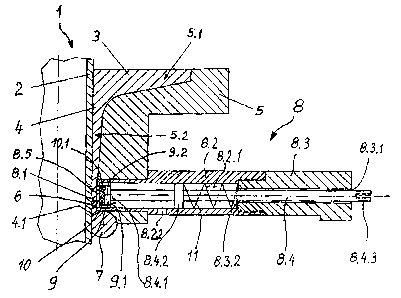Some of the information on this Web page has been provided by external sources. The Government of Canada is not responsible for the accuracy, reliability or currency of the information supplied by external sources. Users wishing to rely upon this information should consult directly with the source of the information. Content provided by external sources is not subject to official languages, privacy and accessibility requirements.
Any discrepancies in the text and image of the Claims and Abstract are due to differing posting times. Text of the Claims and Abstract are posted:
| (12) Patent: | (11) CA 2298678 |
|---|---|
| (54) English Title: | VENTILATION VALVE FOR A MOLD IN PRODUCING INSULATORS |
| (54) French Title: | SOUPAPE DE VENTILATION POUR UN MOULE DANS LA FABRICATION D'ISOLANTS |
| Status: | Term Expired - Post Grant Beyond Limit |
| (51) International Patent Classification (IPC): |
|
|---|---|
| (72) Inventors : |
|
| (73) Owners : |
|
| (71) Applicants : |
|
| (74) Agent: | MARKS & CLERK |
| (74) Associate agent: | |
| (45) Issued: | 2005-10-25 |
| (86) PCT Filing Date: | 1998-07-29 |
| (87) Open to Public Inspection: | 1999-02-18 |
| Examination requested: | 2003-07-09 |
| Availability of licence: | N/A |
| Dedicated to the Public: | N/A |
| (25) Language of filing: | English |
| Patent Cooperation Treaty (PCT): | Yes |
|---|---|
| (86) PCT Filing Number: | PCT/DE1998/002210 |
| (87) International Publication Number: | WO 1999008291 |
| (85) National Entry: | 2000-01-31 |
| (30) Application Priority Data: | ||||||
|---|---|---|---|---|---|---|
|
The aim of the invention is to provide an improved
ventilation valve, especially for ventilating a mould in the
production of umbrella type insulators, so that harmful
deformation of the moulded body can be avoided during removal
from the mould. This is achieved by providing the
ventilation valve with a rod-like or pin-shaped housing with
an orifice on one of its front faces and by providing a valve
body on the other front face which is detachably mounted in
an axial extension of the valve housing.
L'invention vise à perfectionner une soupape de ventilation (8), notamment pour ventiler un moule (5) destiné à la fabrication d'isolateurs type parapluie (1), de manière à éviter une déformation préjudiciable du corps moulé lors de l'extraction du moule (5). A cet effet, la soupape de ventilation (8) est constituée d'un carter (8.2) en forme d'aiguille, sur une face frontale duquel un orifice de soupape (8.5) est disposé et sur une autre face frontale duquel un corps de soupape (8.3) est monté amovible dans le prolongement axial du carter de soupape (8.2).
Note: Claims are shown in the official language in which they were submitted.
Note: Descriptions are shown in the official language in which they were submitted.

2024-08-01:As part of the Next Generation Patents (NGP) transition, the Canadian Patents Database (CPD) now contains a more detailed Event History, which replicates the Event Log of our new back-office solution.
Please note that "Inactive:" events refers to events no longer in use in our new back-office solution.
For a clearer understanding of the status of the application/patent presented on this page, the site Disclaimer , as well as the definitions for Patent , Event History , Maintenance Fee and Payment History should be consulted.
| Description | Date |
|---|---|
| Inactive: Expired (new Act pat) | 2018-07-29 |
| Grant by Issuance | 2005-10-25 |
| Inactive: Cover page published | 2005-10-24 |
| Inactive: Final fee received | 2005-08-10 |
| Pre-grant | 2005-08-10 |
| Letter Sent | 2005-06-17 |
| Notice of Allowance is Issued | 2005-06-17 |
| Notice of Allowance is Issued | 2005-06-17 |
| Inactive: Approved for allowance (AFA) | 2005-05-27 |
| Amendment Received - Voluntary Amendment | 2005-05-04 |
| Inactive: S.30(2) Rules - Examiner requisition | 2005-01-28 |
| Amendment Received - Voluntary Amendment | 2005-01-04 |
| Letter Sent | 2003-08-18 |
| Request for Examination Requirements Determined Compliant | 2003-07-09 |
| Request for Examination Received | 2003-07-09 |
| Amendment Received - Voluntary Amendment | 2003-07-09 |
| All Requirements for Examination Determined Compliant | 2003-07-09 |
| Letter Sent | 2000-11-09 |
| Letter Sent | 2000-11-09 |
| Inactive: Single transfer | 2000-10-12 |
| Inactive: Multiple transfers | 2000-10-12 |
| Inactive: Cover page published | 2000-03-29 |
| Inactive: First IPC assigned | 2000-03-28 |
| Inactive: Courtesy letter - Evidence | 2000-03-21 |
| Inactive: Notice - National entry - No RFE | 2000-03-14 |
| Application Received - PCT | 2000-03-13 |
| Application Published (Open to Public Inspection) | 1999-02-18 |
There is no abandonment history.
The last payment was received on 2005-05-04
Note : If the full payment has not been received on or before the date indicated, a further fee may be required which may be one of the following
Please refer to the CIPO Patent Fees web page to see all current fee amounts.
Note: Records showing the ownership history in alphabetical order.
| Current Owners on Record |
|---|
| HAEFELY TRENCH MWB GMBH |
| TRENCH GERMANY GMBH |
| Past Owners on Record |
|---|
| ALFONS LEICHT |
| HERMANN JEUTHNER |
| JOHANN GEORG WELZ |